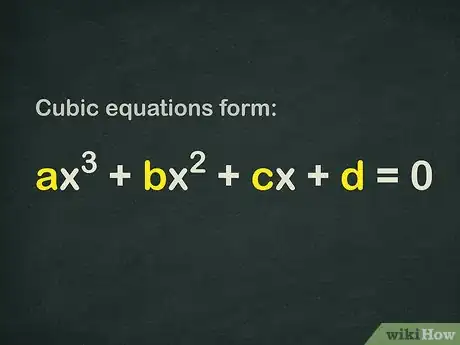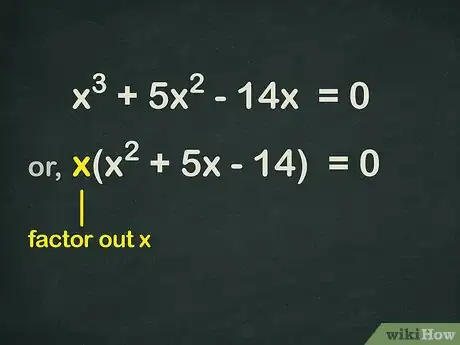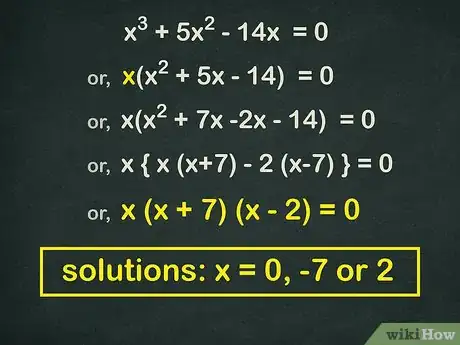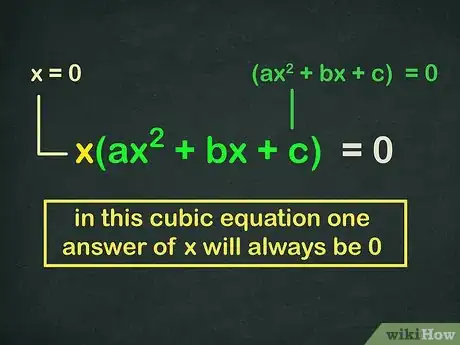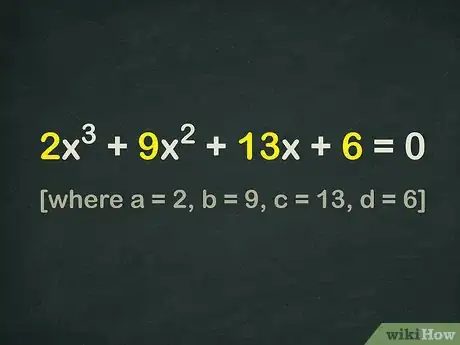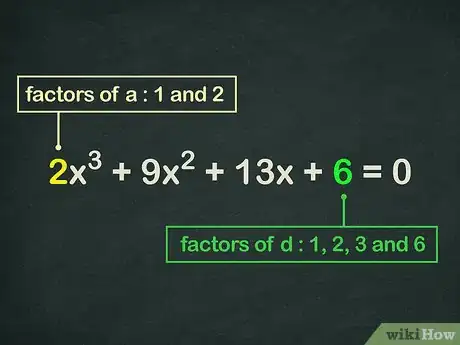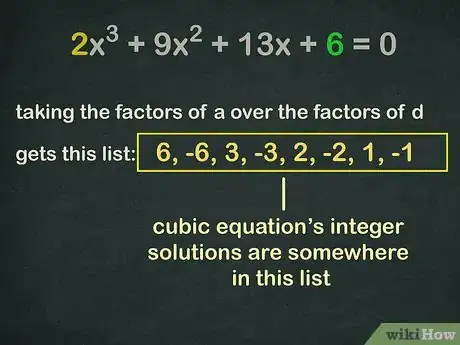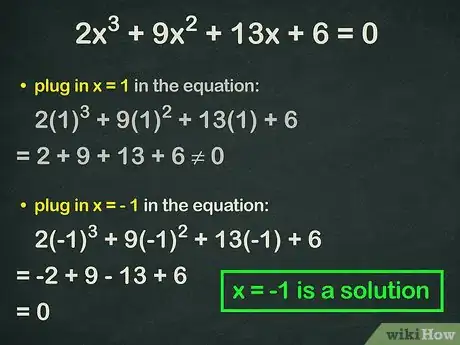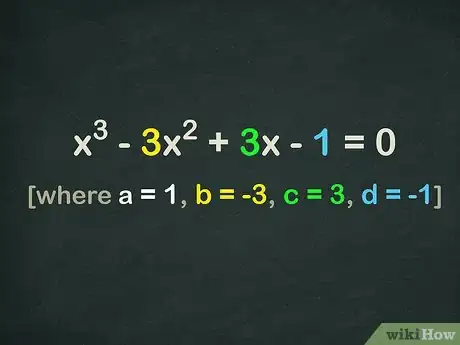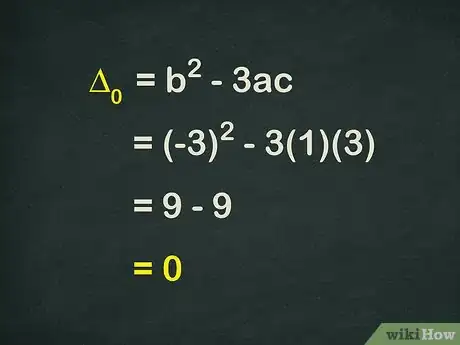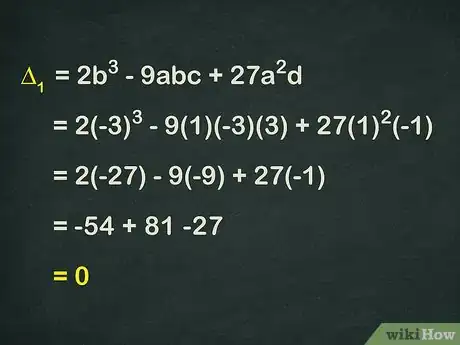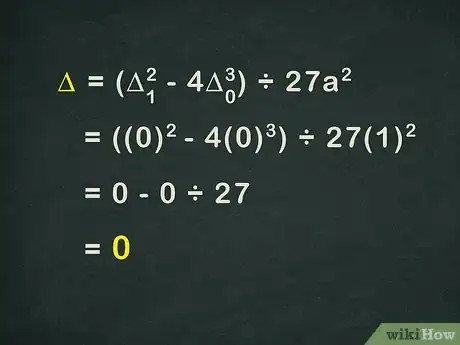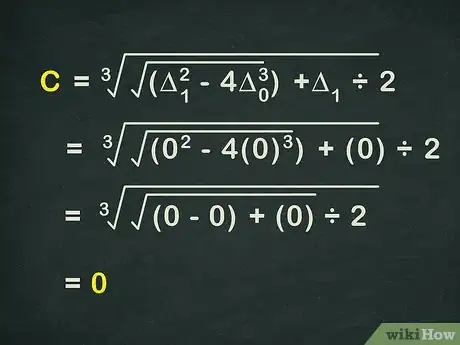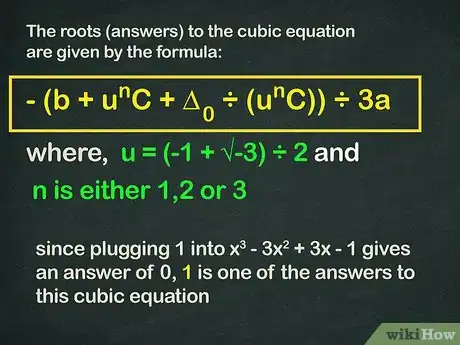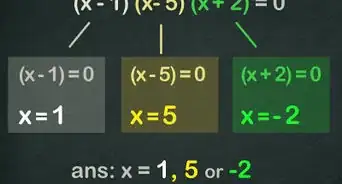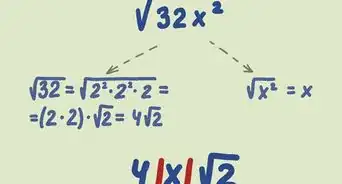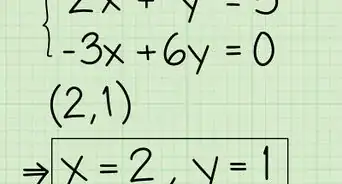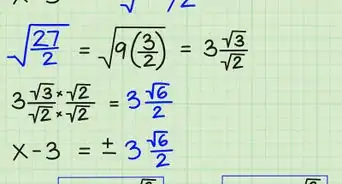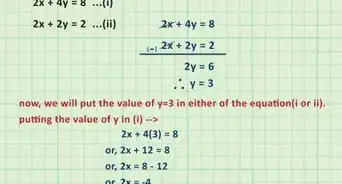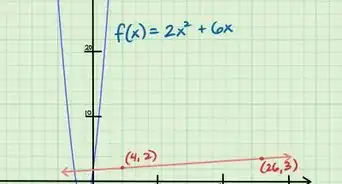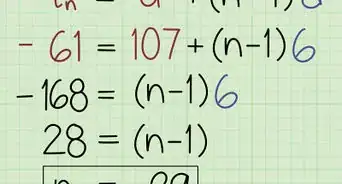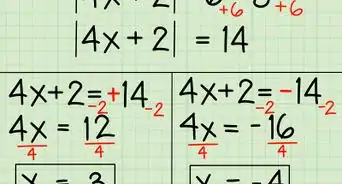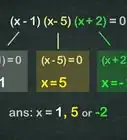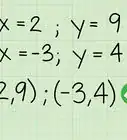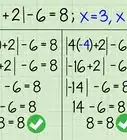This article was co-authored by David Jia and by wikiHow staff writer, Christopher M. Osborne, PhD. David Jia is an Academic Tutor and the Founder of LA Math Tutoring, a private tutoring company based in Los Angeles, California. With over 10 years of teaching experience, David works with students of all ages and grades in various subjects, as well as college admissions counseling and test preparation for the SAT, ACT, ISEE, and more. After attaining a perfect 800 math score and a 690 English score on the SAT, David was awarded the Dickinson Scholarship from the University of Miami, where he graduated with a Bachelor’s degree in Business Administration. Additionally, David has worked as an instructor for online videos for textbook companies such as Larson Texts, Big Ideas Learning, and Big Ideas Math.
This article has been viewed 892,404 times.
In a cubic equation, the highest exponent is 3, the equation has 3 solutions/roots, and the equation itself takes the form . While cubics look intimidating and unlike quadratic equation is quite difficult to solve, using the right approach (and a good amount of foundational knowledge) can tame even the trickiest cubics. You can try, among other options, using the quadratic formula, finding integer solutions, or identifying discriminants.
Steps
Solving Cubic Equations without a Constant
-
1Check whether your cubic contains a constant (a value). Cubic equations take the form . However, the only essential requirement is , which means the other elements need not be present to have a cubic equation.[1]
- If your equation does contain a constant (a value), you'll need to use another solving method.
- If , you do not have a cubic equation.[2]
-
2Factor an out of the equation. Since your equation doesn't have a constant, every term in the equation has an variable in it. This means that one can be factored out of the equation to simplify it. Do this and re-write your equation in the form .[3]
- For example, let's say that your starting cubic equation is
- Factoring a single out of this equation, you get
Advertisement -
3Factor the resulting quadratic equation, if possible. In many cases, you will be able to factor the quadratic equation () that results when you factor the out. For example, if you are given , then you can do the following:[4]
- Factor out the :
- Factor the quadratic in parentheses:
- Set each of these factors equal to. Your solutions are .
- You can also factor it by grouping.
-
4Solve the portion in parentheses with the quadratic formula if you can’t factor it manually. You can find the values for which this quadratic equation equals by plugging , , and into the quadratic formula (). Do this to find two of the answers to your cubic equation.[5]
- In the example, plug your , , and values (, , and , respectively) into the quadratic equation as follows:
- Answer 1:
- Answer 2:
- In the example, plug your , , and values (, , and , respectively) into the quadratic equation as follows:
-
5Use zero and the quadratic answers as your cubic's answers. While quadratic equations have two solutions, cubics have three. You already have two of these — they're the answers you found for the "quadratic" portion of the problem in parentheses. In cases where your equation is eligible for this "factoring" method of solving, your third answer will always be .[6]
- Factoring your equation into the form splits it into two factors: one factor is the variable on the left, and the other is the quadratic portion in parentheses. If either of these factors equals , the entire equation will equal .
- Thus, the two answers to the quadratic portion in parentheses, which will make that factors equal , are answers to the cubic, as is itself, which will make the left factor equal .
Finding Integer Solutions with Factor Lists
-
1Ensure your cubic has a constant (a nonzero value). If your equation in the form has a nonzero value for , factoring with the quadratic equation won't work. But don’t worry—you have other options, like the one described here![7]
- Take, for example, . In this case, getting a on the right side of the equals sign requires you to add to both sides.
- In the new equation, . Since , you can't use the quadratic equation method.
-
2Find the factors of and . Start solving the cubic equation by finding the factors of the coefficient of the term (that is, ) and the constant at the end of the equation (that is, ). Remember that factors are the numbers that can multiply together to make another number.[8]
- For example, since you can make 6 by multiplying and , that means 1, 2, 3, and 6 are the factors of 6.
- In the sample problem, and . The factors of 2 are 1 and 2. The factors of 6 are 1, 2, 3, and 6.
-
3Divide the factors of by the factors of . Make a list of the values you get by dividing each factor of by each factor of . This will usually result in lots of fractions and a few whole numbers. The integer solutions to your cubic equation will either be one of the whole numbers in this list or the negative of one of these numbers.[9]
- In the sample equation, taking the factors of (1, 2, 3 and 6) over the factors of (1 and 2) gives this list: , , , , , , and . Your cubic equation's solutions are somewhere in this list.
-
4Plug in the integers manually for a simpler but possibly time-consuming approach. Once you have your list of values, you can find the integer answers to your cubic equation by quickly plugging each integer in manually and finding which ones equal . For instance, if you plug in , you get:[10]
- , or , which clearly does not equal . So, move on to the next value on your list.
- If you plug in , you get , which does equal . This means is one of your integer solutions.
-
5Employ synthetic division for a more complex but likely faster approach. If you don't want to spend the time plugging in values one by one, try a quicker method that involves a technique called synthetic division. Basically, you'll want to synthetically divide your integer values by the original , , , and coefficients in your cubic equation. If you get a remainder of , your value is one of the cubic equation's answers.[11]
- Synthetic division is a complex topic that’s beyond the scope of describing fully here. However, here's a sample of how to find one of the solutions to your cubic equation with synthetic division:
- -1 | 2 9 13 6
- __| -2-7-6
- __| 2 7 6 0
- Since you got a final remainder of , you know that one of your cubic's integer solutions is .
- Synthetic division is a complex topic that’s beyond the scope of describing fully here. However, here's a sample of how to find one of the solutions to your cubic equation with synthetic division:
Using a Discriminant Approach
-
1Write out the values of , , , and . For this method you’ll be dealing heavily with the coefficients of the terms in your equation. Record your , , , and terms before you begin so you don't forget what each one is.[12]
- For the sample equation , write , , , and . Don't forget that when an variable doesn't have a coefficient, it's implicitly assumed that its coefficient is .
-
2Calculate the discriminant of zero using the proper formula. The discriminant approach to finding a cubic equation's solution requires some complicated math, but if you follow the process carefully, you'll find that it's an invaluable tool for figuring out those cubic equations that are hard to crack any other way. To start, find (the discriminant of zero), the first of several important quantities we'll need, by plugging the appropriate values into the formula .[13]
- A discriminant is simply a number that gives us information about the roots of a polynomial (you may already know the quadratic discriminant: ).
- In your sample problem, solve as follows:
-
3Follow up by calculating . The next important quantity you’ll need, (the discriminant of ), requires a little more work, but is found in essentially the same way as . Plug the appropriate values into the formula to get your value for .[14]
- In the example, solve as follows:
- In the example, solve as follows:
-
4Calculate: . Next, we'll calculate the discriminant of the cubic from the values of and . In the case of the cubic, if the discriminant is positive, then the equation has three real solutions. If the discriminant is zero, then the equation has either one or two real solutions, and some of those solutions are shared. If it is negative, then the equation has only one solution.[15]
- A cubic equation always has at least one real solution, because the graph will always cross the x-axis at least once.
- In the example, since both and , finding is relatively easy. Solve as follows:
- , so the equation has one or two answers.
-
5Calculate: . The last important value we need to calculate is . This important quantity will allow us to finally find our three roots. Solve as normal, substituting and as needed.
- In your example, find as follows:
- In your example, find as follows:
-
6Calculate the three roots with your variables. The roots (answers) to your cubic equation are given by the formula , where and n is either 1, 2, or 3. Plug in your values as needed to solve — this requires lots of mathematical legwork, but you should receive three viable answers!
- You can solve the example by checking the answer when n is equal to 1, 2, and 3. The answers you get from these tests are the possible answers to the cubic equation — any that give an answer of 0 when plugged into the equation are correct.
- For example, since plugging 1 into gives an answer of 0, 1 is one of the answers to your cubic equation.
Practice Problems and Answers
Expert Q&A
-
QuestionHow do you solve a simple cubic equation?
 David JiaDavid Jia is an Academic Tutor and the Founder of LA Math Tutoring, a private tutoring company based in Los Angeles, California. With over 10 years of teaching experience, David works with students of all ages and grades in various subjects, as well as college admissions counseling and test preparation for the SAT, ACT, ISEE, and more. After attaining a perfect 800 math score and a 690 English score on the SAT, David was awarded the Dickinson Scholarship from the University of Miami, where he graduated with a Bachelor’s degree in Business Administration. Additionally, David has worked as an instructor for online videos for textbook companies such as Larson Texts, Big Ideas Learning, and Big Ideas Math.
David JiaDavid Jia is an Academic Tutor and the Founder of LA Math Tutoring, a private tutoring company based in Los Angeles, California. With over 10 years of teaching experience, David works with students of all ages and grades in various subjects, as well as college admissions counseling and test preparation for the SAT, ACT, ISEE, and more. After attaining a perfect 800 math score and a 690 English score on the SAT, David was awarded the Dickinson Scholarship from the University of Miami, where he graduated with a Bachelor’s degree in Business Administration. Additionally, David has worked as an instructor for online videos for textbook companies such as Larson Texts, Big Ideas Learning, and Big Ideas Math.
Academic Tutor If you only have x³ in an equation, you can isolate it and find the cube root of both sides. This only works with really simple equations, though—factoring is the best way to solve more complex equations.
If you only have x³ in an equation, you can isolate it and find the cube root of both sides. This only works with really simple equations, though—factoring is the best way to solve more complex equations. -
QuestionHow would I solve xy+z+z^3=1?
 Community AnswerThat equation has numerous answers because you've got three variables. To get one answer for three variables you need three equations. One possible answer would be x=1, y=-1, z=1 => (1)(-1)+1+1^3=1.
Community AnswerThat equation has numerous answers because you've got three variables. To get one answer for three variables you need three equations. One possible answer would be x=1, y=-1, z=1 => (1)(-1)+1+1^3=1. -
QuestionThe question is: if 3 consecutive even numbers are multiplied and the result would be 960. What are those numbers and how did you did with the step?
 Elvis KiprotichCommunity AnswerSolve the equation using the discriminant approach you will get three values of x. X=8, X=-7+(-1i)√71, X=-7+i√71. Easy from here, you pick the real value of x, that's 8 and your three numbers were 8, 10 and 12.
Elvis KiprotichCommunity AnswerSolve the equation using the discriminant approach you will get three values of x. X=8, X=-7+(-1i)√71, X=-7+i√71. Easy from here, you pick the real value of x, that's 8 and your three numbers were 8, 10 and 12.
References
- ↑ http://www.mathcentre.ac.uk/resources/uploaded/mc-ty-cubicequations-2009-1.pdf
- ↑ https://sciencing.com/solve-cubic-equations-8136094.html
- ↑ https://sciencing.com/solve-cubic-equations-8136094.html
- ↑ http://www.mathcentre.ac.uk/resources/uploaded/mc-ty-cubicequations-2009-1.pdf
- ↑ https://www.purplemath.com/modules/quadform.htm
- ↑ https://math.vanderbilt.edu/schectex/courses/cubic/
- ↑ http://www.rasmus.is/uk/t/F/Su52k02.htm
- ↑ http://www.rasmus.is/uk/t/F/Su52k02.htm
- ↑ http://www.rasmus.is/uk/t/F/Su52k02.htm
- ↑ http://www.rasmus.is/uk/t/F/Su52k02.htm
- ↑ http://www.rasmus.is/uk/t/F/Su52k02.htm
- ↑ http://www2.trinity.unimelb.edu.au/~rbroekst/MathX/Cubic%20Formula.pdf
- ↑ http://www2.trinity.unimelb.edu.au/~rbroekst/MathX/Cubic%20Formula.pdf
- ↑ http://www2.trinity.unimelb.edu.au/~rbroekst/MathX/Cubic%20Formula.pdf
- ↑ http://www2.trinity.unimelb.edu.au/~rbroekst/MathX/Cubic%20Formula.pdf
About This Article
To solve a cubic equation, start by determining if your equation has a constant. If it doesn't, factor an x out and use the quadratic formula to solve the remaining quadratic equation. If it does have a constant, you won't be able to use the quadratic formula. Instead, find all of the factors of a and d in the equation and then divide the factors of a by the factors of d. Then, plug each answer into the equation to see which one equals 0. Whichever integer equals 0 is your answer. Read on to learn how to solve a cubic equation using a discriminant approach!

